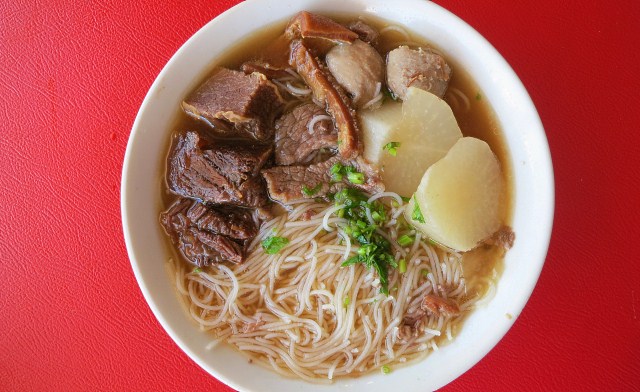Looking for excellent Ngiu Chap (mixed beef)? Your stomach will find its love at Kah Hiong Ngiu Chap. As the most famous brand of Sabah Ngiu Chap, Kah Hiong Ngiu Chap is so specialized in Ngiu Chap that you can enjoy Ngiu Chap in various way, and in traditional and new styles.
Look at their “user-friendly” pictorial menu below:
You can have Ngiu Chap served with Meehoon (thin rice noodle soup), Mee (fat yellow noodle soup), Konlou Mee (dry yellow noodle style), rice, soup-only, etc. If you like specific beef part, you can order a whole bowl for your full enjoyment. Just click the picture above for detail. To 1st-timer who is not used to organs, beef balls and stew meat would be your safe choices.
(Note: prices as of Nov 2012, USD1≈MYR3)
I ordered the standard Ngiu Chap rice noodle soup, which consists of stew meat, fresh meat, beef ball and tripe.
The Ngiu Chap of Kah Hiong is considered as West Malaysia style, as they add white radish, which enhances the meaty sweet taste of beef. I like it.
The beef is fresh and springy, very well-marinated as well.
Overall, the Ngiu Chap is really good. I’m only a bit disappointed that beef tendon is not in standard serving (you need to pay extra to have tendon, spleen, tongue and intestine).
For normal serving, Ngiu Chap noodle soup costs MYR8.00 (≈USD2.25), MYR8.50 (≈USD2.35) if KonLau style (dry noodle). (Prices as of Feb 2015)
Oh, BTW, another “secret weapon” of Kah Hiong Ngiu Chap is their super hot chili paste. Dip your beef into it (a bit only, you have been warned) for extra kick. Somehow strong chili goes very well with Ngiu Chap.
Their chili paste is made of very spicy small chili called “Cili Padi” (a.k.a. Bird’s eye chili or Thai chili). You can buy a bottle of their famous chili paste for MYR10 (≈USD3.33).
How to Get There
Hungry? Let’s go for a yummy Ngiu Chap today. Kah Hiong Ngiu Chap is in Luyang Hilltop, only 5 KM from Kota Kinabalu city.
Address: Block A Shop, No. 2-0-10 Kolam Centre Phase 2, Ground Floor, Jalan Lintas, Kolam Centre, Luyang, Kota Kinabalu, Sabah, Malaysia.
Tel: +60 88-254161
Opening Hours: 7am – 3pm daily
They rest one day every month, so you better call them before visit.
Below is the location map of Kah Hiong Ngiu Chap (main shop):
View My Sabah Map in a larger map
Branches
Kah Hiong Ngiu Chap also has two branches. Below are the location and contact info:
1. Donggongon
Address: Block B, Lot 14, Ground Floor, Kedai Plaza Grand Millennium, Jalan Pintas, Donggongon, Penampang, Kota Kinabalu, Sabah, Malaysia.
Tel: +60 88-731646
2. Brunei
Address: No. 21, Ground Floor, Block E, Complex Hj Daud, Jalan Gadong, BE2719, BSB, Negara Brunei Darussalam.
Tel: +673 244 3078
Photos taken in Kota Kinabalu, Sabah, Malaysia Borneo
